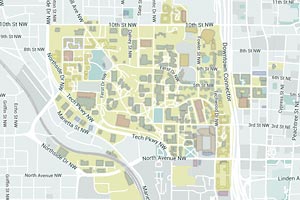Speaker: Dr. Jose Onuchic
Host: Harold Kim & Shila Banerjee
Title: Modeling the Genome: A View by a Physicist
Abstract: In vivo, the human genome folds into a characteristic ensemble of 3D structures. The mechanism driving the folding process remains unknown. A theoretical model for chromatin (the minimal chromatin model) explains the folding of interphase chromosomes and generates chromosome conformations consistent with experimental data is presented. The energy landscape of the model was derived by using the maximum entropy principle and relies on two experimentally derived inputs: a classification of loci into chromatin types and a catalog of the positions of chromatin loops. This model was generalized by utilizing a neural network to infer these chromatin types using epigenetic marks present at a locus, as assayed by ChIP-Seq. The ensemble of structures resulting from these simulations completely agree with HIC data and exhibits unknotted chromosomes, phase separation of chromatin types, and a tendency for open chromatin to lie at the periphery of chromosome territories. Although this theoretical methodology was trained in one cell line, the human GM12878 lymphoblastoid cells, it has successfully predicted the structural ensembles of multiple human cell lines. Finally, going beyond Hi-C, our predicted structures are also consistent with microscopy measurements. Analysis of both structures from simulation and microscopy reveals that short segments of chromatin make two-state transitions between closed conformations and open dumbbell conformations. For gene active segments, the vast majority of genes appear clustered in the linker region of the chromatin segment, allowing us to speculate possible mechanisms by which chromatin structure and dynamics may be involved in controlling gene expression.
* Supported by the NSF
Bio: José Onuchic is the Harry C & Olga K Wiess Professor of Physics and Astronomy, Chemistry and Biosciences at Rice University and the co-Director of the NSF-sponsored Center for Theoretical Biological Physics. His research looks at theoretical methods for molecular biophysics and gene networks. He introduced the concept of protein folding funnels. Energy landscape theory and the funnel concept provide the framework needed to pose and to address the questions of protein folding and function mechanisms. He developed the tunneling pathways concept for electron transfer in proteins. He is also interested in stochastic effects in genetic networks with applications to bacteria decision-making and cancer. Further expanding his ideas coming from energy landscapes for protein folding, his group is now exploring chromatin folding and function and therefore modeling the 3D structure of the genome. He has received much recognition for his achievements. He was elected to the National Academy of Sciences in 2006. He received the ICTP Prize in honor of Heisenberg in Trieste, Italy (1989) and the Beckman Young Investigator Award (1992). He is a fellow of the American Physical Society (1995), the American Academy of Arts and Sciences (2009), the Brazilian Academy of Sciences (2009), the Biophysical Society (2012) and the American Association for the Advancement of Science (2017). He received the Einstein Professorship by the Chinese Academy of Sciences (2011). In 2014 he received the Diaspora Prize from the Ministry of Foreign Affairs and the Ministry of Industrial Development and Foreign Trade from Brazil. In 2015 he received The International Union of Biochemistry and Molecular Biology Medal. In 2018 he received National Order of Scientific Merit by the Brazilian National Council in Science and Technology. He received the 2019 American Physical Society’s Max Delbruck Prize in Biological Physics and was elected to Pontifical Academy of Sciences in 2020. In 2023, he received the Founders Award by the Biophysical Society.
Event Details
Date/Time:
-
Date:Monday, September 29, 2025 - 3:30pm to 4:30pm
Location:
Marcus Nanotechnology 1116-1118


